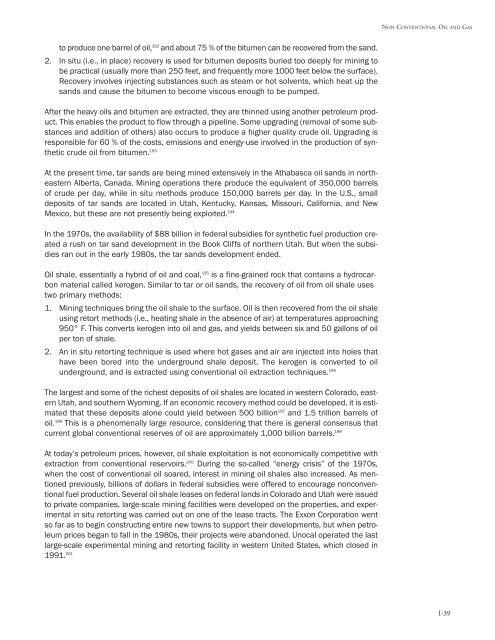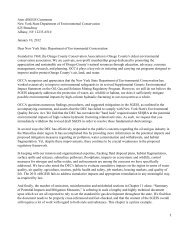Oil and Gas at Your Door? (2005 Edition) - Earthworks
Oil and Gas at Your Door? (2005 Edition) - Earthworks
Oil and Gas at Your Door? (2005 Edition) - Earthworks
You also want an ePaper? Increase the reach of your titles
YUMPU automatically turns print PDFs into web optimized ePapers that Google loves.
NON CONVENTIONAL OIL AND GAS<br />
to produce one barrel of oil, 192 <strong>and</strong> about 75 % of the bitumen can be recovered from the s<strong>and</strong>.<br />
2. In situ (i.e., in place) recovery is used for bitumen deposits buried too deeply for mining to<br />
be practical (usually more than 250 feet, <strong>and</strong> frequently more 1000 feet below the surface).<br />
Recovery involves injecting substances such as steam or hot solvents, which he<strong>at</strong> up the<br />
s<strong>and</strong>s <strong>and</strong> cause the bitumen to become viscous enough to be pumped.<br />
After the heavy oils <strong>and</strong> bitumen are extracted, they are thinned using another petroleum product.<br />
This enables the product to flow through a pipeline. Some upgrading (removal of some substances<br />
<strong>and</strong> addition of others) also occurs to produce a higher quality crude oil. Upgrading is<br />
responsible for 60 % of the costs, emissions <strong>and</strong> energy-use involved in the production of synthetic<br />
crude oil from bitumen. 193<br />
At the present time, tar s<strong>and</strong>s are being mined extensively in the Athabasca oil s<strong>and</strong>s in northeastern<br />
Alberta, Canada. Mining oper<strong>at</strong>ions there produce the equivalent of 350,000 barrels<br />
of crude per day, while in situ methods produce 150,000 barrels per day. In the U.S., small<br />
deposits of tar s<strong>and</strong>s are loc<strong>at</strong>ed in Utah, Kentucky, Kansas, Missouri, California, <strong>and</strong> New<br />
Mexico, but these are not presently being exploited. 194<br />
In the 1970s, the availability of $88 billion in federal subsidies for synthetic fuel production cre<strong>at</strong>ed<br />
a rush on tar s<strong>and</strong> development in the Book Cliffs of northern Utah. But when the subsidies<br />
ran out in the early 1980s, the tar s<strong>and</strong>s development ended.<br />
<strong>Oil</strong> shale, essentially a hybrid of oil <strong>and</strong> coal, 195 is a fine-grained rock th<strong>at</strong> contains a hydrocarbon<br />
m<strong>at</strong>erial called kerogen. Similar to tar or oil s<strong>and</strong>s, the recovery of oil from oil shale uses<br />
two primary methods:<br />
1. Mining techniques bring the oil shale to the surface. <strong>Oil</strong> is then recovered from the oil shale<br />
using retort methods (i.e., he<strong>at</strong>ing shale in the absence of air) <strong>at</strong> temper<strong>at</strong>ures approaching<br />
950° F. This converts kerogen into oil <strong>and</strong> gas, <strong>and</strong> yields between six <strong>and</strong> 50 gallons of oil<br />
per ton of shale.<br />
2. An in situ retorting technique is used where hot gases <strong>and</strong> air are injected into holes th<strong>at</strong><br />
have been bored into the underground shale deposit. The kerogen is converted to oil<br />
underground, <strong>and</strong> is extracted using conventional oil extraction techniques. 196<br />
The largest <strong>and</strong> some of the richest deposits of oil shales are loc<strong>at</strong>ed in western Colorado, eastern<br />
Utah, <strong>and</strong> southern Wyoming. If an economic recovery method could be developed, it is estim<strong>at</strong>ed<br />
th<strong>at</strong> these deposits alone could yield between 500 billion 197 <strong>and</strong> 1.5 trillion barrels of<br />
oil. 198 This is a phenomenally large resource, considering th<strong>at</strong> there is general consensus th<strong>at</strong><br />
current global conventional reserves of oil are approxim<strong>at</strong>ely 1,000 billion barrels. 199<br />
At today’s petroleum prices, however, oil shale exploit<strong>at</strong>ion is not economically competitive with<br />
extraction from conventional reservoirs. 200 During the so-called “energy crisis” of the 1970s,<br />
when the cost of conventional oil soared, interest in mining oil shales also increased. As mentioned<br />
previously, billions of dollars in federal subsidies were offered to encourage nonconventional<br />
fuel production. Several oil shale leases on federal l<strong>and</strong>s in Colorado <strong>and</strong> Utah were issued<br />
to priv<strong>at</strong>e companies, large-scale mining facilities were developed on the properties, <strong>and</strong> experimental<br />
in situ retorting was carried out on one of the lease tracts. The Exxon Corpor<strong>at</strong>ion went<br />
so far as to begin constructing entire new towns to support their developments, but when petroleum<br />
prices began to fall in the 1980s, their projects were ab<strong>and</strong>oned. Unocal oper<strong>at</strong>ed the last<br />
large-scale experimental mining <strong>and</strong> retorting facility in western United St<strong>at</strong>es, which closed in<br />
1991. 201 I-39




